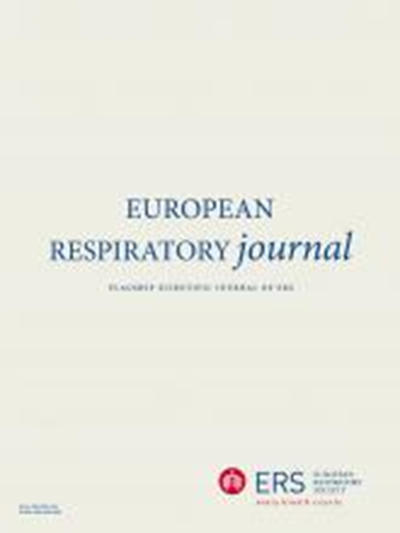Short telomere length is associated with accelerated lung disease progression in rheumatoid arthritis-associated interstitial lung disease.
IF 21
1区 医学
Q1 RESPIRATORY SYSTEM
引用次数: 0
Abstract
BACKGROUND Shorter leukocyte telomere length (LTL) has been reported in patients with rheumatoid arthritis (RA)-associated interstitial lung disease (ILD) and linked to increased disease severity and mortality in idiopathic pulmonary fibrosis, which shares similarities with RA-ILD. We aimed to evaluate the impact of short LTL on baseline respiratory disease severity, disease progression and survival in patients with RA-ILD. METHODS Patients diagnosed with RA-ILD following multidisciplinary assessment were enrolled in a prospective French observational study. LTL was measured at enrolment using qPCR. Short LTL was defined as age-adjusted LTL<10th percentile. Lung disease progression was defined as death, lung transplant or functional respiratory decline (absolute decrease in forced vital capacity (FVC) ≥5%predicted, transfer capacity (TLCO) ≥10%predicted). RESULTS Among 101 patients with RA-ILD, 46% were male, mean age at enrolment was 66±10 years and 43 (43%) had short LTL. Patients with short LTL had lower FVC (82% versus 93%predicted) and TLCO (49% versus 63%predicted) at enrolment, and greater 12-months decline in FVC and DLCO in mixed effects models (-7.7%pred. 95%CI[-11.6,-3.8] p<0.001, -4.5%pred. [-7.2, -1.8] p=0.001, respectively), although transplant-free survival was similar over a median follow-up of 3.6 years (IQR[1.8,7.0]). Lung disease progression was observed within 12 months of enrolment in 33 patients (33%), more frequently in patients with short LTL (47% versus 22%, p univariate=0.011) and lower FVC at enrolment. Multivariate logistic regression identified lower FVC and short LTL as predictors of 12-month progression (OR 0.97 95%CI[0.94,1.00] p=0.031 and 2.80 [0.99,8.29] p=0.056, respectively). CONCLUSIONS Short LTL is associated with baseline severity and 12-month progression in RA-ILD.短端粒长度与类风湿关节炎相关间质性肺病的加速肺病进展有关。
背景:在类风湿关节炎(RA)相关间质性肺疾病(ILD)患者中,白细胞端粒长度(LTL)较短,与特发性肺纤维化患者疾病严重程度和死亡率增加有关,这与RA-ILD有相似之处。我们的目的是评估短LTL对RA-ILD患者基线呼吸系统疾病严重程度、疾病进展和生存的影响。方法:多学科评估后诊断为RA-ILD的患者入组法国一项前瞻性观察性研究。入组时使用qPCR测量LTL。短LTL定义为年龄调整后的LTL<10百分位。肺部疾病进展定义为死亡、肺移植或功能性呼吸衰退(预测用力肺活量(FVC)绝对下降≥5%,预测肺活量(TLCO)绝对下降≥10%)。结果101例RA-ILD患者中,46%为男性,入组时平均年龄66±10岁,43例(43%)LTL较短。LTL较短的患者入组时FVC(82%,预期为93%)和TLCO(49%,预期为63%)较低,混合效应模型中FVC和DLCO的12个月下降幅度较大(预期为-7.7%)。95%CI[-11.6,-3.8] p<0.001, -4.5%pred。[-7.2, -1.8] p=0.001),尽管中位随访3.6年的无移植生存期相似(IQR[1.8,7.0])。33例患者(33%)在入组12个月内观察到肺部疾病进展,更常见的是LTL较短的患者(47%对22%,p单变量=0.011)和入组时FVC较低的患者。多因素logistic回归发现较低的FVC和较短的LTL是12个月进展的预测因子(OR = 0.97 95%CI[0.94,1.00] p=0.031和2.80 [0.99,8.29]p=0.056)。结论:短期LTL与RA-ILD的基线严重程度和12个月进展相关。
本文章由计算机程序翻译,如有差异,请以英文原文为准。
求助全文
约1分钟内获得全文
求助全文
来源期刊

European Respiratory Journal
医学-呼吸系统
CiteScore
27.50
自引率
3.30%
发文量
345
审稿时长
2-4 weeks
期刊介绍:
The European Respiratory Journal (ERJ) is the flagship journal of the European Respiratory Society. It has a current impact factor of 24.9. The journal covers various aspects of adult and paediatric respiratory medicine, including cell biology, epidemiology, immunology, oncology, pathophysiology, imaging, occupational medicine, intensive care, sleep medicine, and thoracic surgery. In addition to original research material, the ERJ publishes editorial commentaries, reviews, short research letters, and correspondence to the editor. The articles are published continuously and collected into 12 monthly issues in two volumes per year.
 求助内容:
求助内容: 应助结果提醒方式:
应助结果提醒方式:


